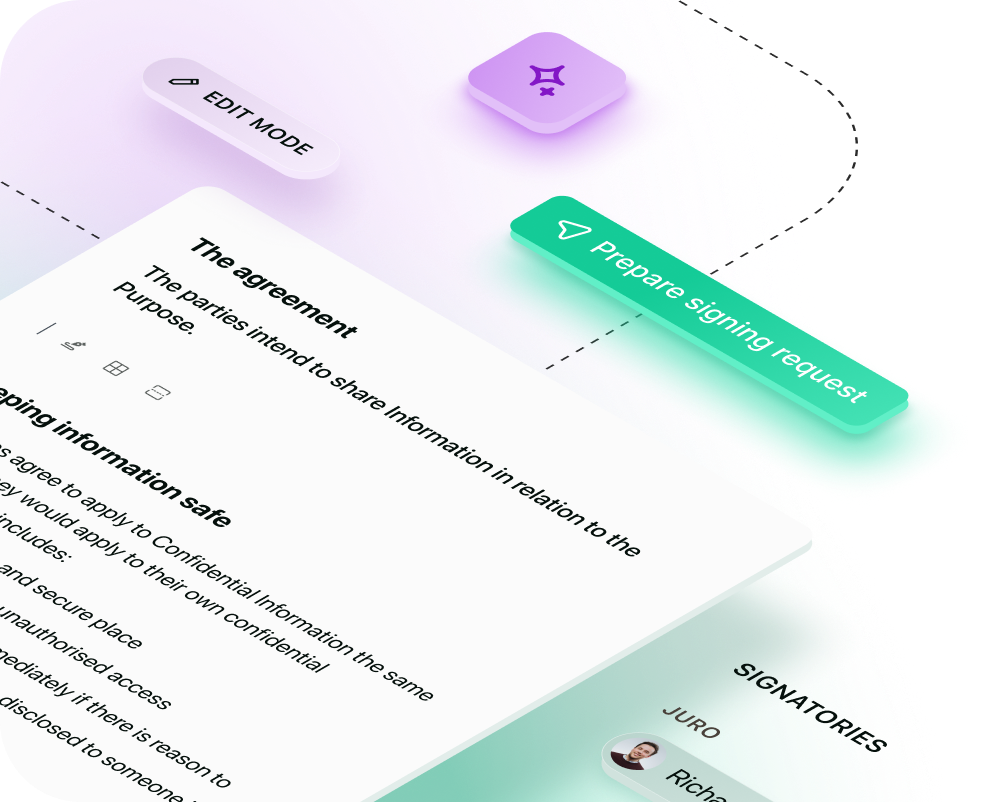Solutions
Customer Support
Resources
Managing commercial or residential property leases in California? Try this free California lease agreement template.




A California lease agreement is a legally binding document that sets out the terms and conditions for renting residential or commercial property in the state of California.
It's designed to ensure that landlords and tenants are fully aligned on their expectations of each other, and that all leases comply with state legislation.
Before you jump into a lease agreement in California, you'll want to get a better understanding of what the landscape looks like for landlords and tenants. Here are a few headlines:
.avif)
Lease agreements in California are primarily governed by the California Civil Code, which covers extensive legal ground concerning tenant and landlord rights, responsibilities, and procedures. Key areas include:
Under these provisions, landlords can only charge up to two months' rent for unfurnished units and three months for furnished units. The deposit must be returned within 21 days of move-out, with itemized deductions for damages, unpaid rent, or cleaning beyond normal wear and tear.
This section details how landlords must maintain units in liveable condition, ensuring working plumbing, heating, electricity, and a safe structure. Tenants can withhold rent, repair and deduct, or move out if habitability issues persist.
Under Civil Code § 1946, California evictions require proper notice. This notice is outlined as follows:
This legislation also distinguishes between just cause evictions and no-fault evictions:
Under California's Tenant Protection Act, rent increases capped for most rental properties built before 2009, but some properties will be exempt.
Notably, local ordinances in cities like Los Angeles, Oakland, and San Francisco often impose stricter controls.
On top of this, landlords in California must also adhere to federal regulations, such as the Fair Housing Act, which prevents discrimination based on race, color, national origin, religion, sex, familial status, or disability.

Lease agreements are typically managed by landlords or property management companies who act on behalf of landlords.
The managers’ responsibilities include: drafting and customizing lease agreements based on the template; ensuring leases comply with all applicable laws; collecting rents and managing security deposits; addressing tenant concerns and maintaining the habitability of the premises, and executing lease renewals and terminations.
In most cases, specialized legal teams may oversee the agreements to ensure ongoing compliance with real estate laws in California, and manage any contractual disputes.
California lease agreements are used whenever a property owner (landlord) rents out residential or commercial property to a tenant under specific terms. More specifically, there are a few common lease agreement uses cases in California:
Residential lease agreements, also known as tenancy agreements, are used for renting homes, apartments, or condos. They typically have a fixed term (e.g., 12 months) or are month-to-month agreements.
Example: A family rents an apartment in Los Angeles under a 12-month lease. The agreement specifies the monthly rent, due dates, security deposit amount, and rules about pets or noise.
Commercial lease agreements are used for renting out commercial spaces, such as offices, retail stores, or industrial warehouses. They often involve longer terms and more complex negotiations.
Example: A small business rents an office in San Francisco for three years. The office lease agreement outlines rent, maintenance responsibilities, and what types of businesses can operate in the space.
Short-term lease agreements apply to short-term rentals, often used for vacation homes or Airbnb-style properties. They typically cover shorter periods (a few days to a few months).
Example: A couple rents a beach house in San Diego for a week. The vacation or airbnb agreement covers the rental dates, total cost, and rules about property use during their stay.
When landowners lease their land for agricultural purposes, such as farming or grazing, these agreements detail land use and often include terms for maintenance and crop sharing, among other things
Example: A farmer leases 50 acres of land in the Central Valley for growing crops. The land lease agreement details the permitted crops, rent based on harvest yield, and water rights.

In all cases, the lease agreement serves to legally protect both parties by clearly defining the terms of the rental relationship. For it to do this properly, you'll need to make sure your California lease agreement is drafted using a robust template, and that it covers everything it needs to.
A comprehensive California lease agreement template should include the following key elements to ensure landlords and tenants clearly understand their rights and obligations under California law.

Managing California lease agreement templates manually typically involves several steps. Let's explore each of these stages in a bit more detail now.
Landlords or property management companies often consult with legal professionals to ensure the lease agreement complies with state and local laws, including the California Civil Code and any applicable local rent control ordinances.
Legal advice is especially important for ensuring that all tenant rights, disclosures, and landlord obligations are included.
The landlord or property manager creates a standardized lease agreement template that complies with California state laws. This document is often drafted by a legal professional to ensure all legal requirements are met.
In some cases, these standard lease agreement templates will already exist and can be customized to meet the specific terms of the rental property and the landlord's preferences.
For each new lease, the landlord or property manager manually updates the template with specific details such as the tenant’s name, the property address, rent amount, lease term, and other relevant information. Adding things like local ordinances or rent control rules is particularly common at this stage.
Before a lease agreement is finalized, there is often a negotiation phase between the landlord (or property manager) and the tenant. This step allows both parties to discuss and agree on specific terms. This doesn't usually involve much contract redlining, but rental amounts and payment terms sometimes come into question.
Once customized, the lease agreement is printed out and signed by both the landlord and the tenant. This usually involves arranging a meeting where both parties can review and sign the document.
However, some more sophisticated workflows will enable the parties to sign the document digitally using an electronic signature. This offers a more convenient way to close the deal.
Post-signature, copies of the signed lease agreement are made. Both the landlord and the tenant keep a copy for their records.
The landlord or property manager files their copy of the signed lease agreement in a physical or digital filing system. This might involve storing paper copies in a filing cabinet or scanning and saving digital copies on a computer or cloud storage service.
It's wise to capture the key contract data at this point, but this is a step often overlooked by most California-based landlords and letting agencies.
As the lease term approaches its end, the landlord or property manager manually reviews the agreement to determine if it will be renewed or terminated. If renewing, the process starts again with updating the template and obtaining new signatures. If terminating, the landlord ensures all end-of-lease procedures are followed, such as final inspections and return of the security deposit.
Depending on the outcome, you might find these templates useful:
However, managing lease agreements manually can be time-consuming and prone to errors, which is why many landlords and property managers are moving towards digital contracting solutions, like Juro, that streamline these processes.
Juro's AI-native contract management platform offers real estate professionals and landlords a faster, more convenient way to manage their real estate contracts, from lease agreements to rent-to-own agreements, and real estate purchase contracts.
Here’s how.
Juro allows landlords and property managers to create automated contract templates that comply with California’s legal requirements. These templates can be easily customized to include key lease terms like rent amount, security deposits, maintenance responsibilities, and disclosures (e.g., lead paint, mold).
The platform also includes dynamic fields that can be filled in automatically, ensuring that tenant-specific details such as names, rental amounts, and lease dates are quickly populated without the need for manual data entry.
Additionally, Juro's customizable rules, conditions, and workflows can ensure lease agreements meet all the requirements of California’s Civil Code and local ordinances (e.g., rent control in cities like Los Angeles or San Francisco), varying these per location.

Juro enables real-time contract collaboration, allowing landlords and tenants to negotiate lease terms directly in the document. The platform eliminates back-and-forth emails by letting both parties suggest edits, add comments, and agree on terms all within the contract itself.
Juro tracks all changes made during contract negotiations, providing a clear audit trail. This is crucial for lease agreements where terms like rent amounts, lease duration, and maintenance responsibilities may be subject to negotiation.
If a landlord requires internal approvals (e.g., from property management teams or legal advisors), Juro’s automated approval workflows can route the agreement to the appropriate people for approval before finalizing the lease.
-min.avif)
Juro provides a way to add legally binding electronic signatures, making it easy for both landlords and tenants to sign the lease agreement online without needing physical paperwork. This speeds up the contract execution process and ensures that the contract is signed securely and in compliance with California law.
Juro is also browser-native, meaning both parties can access, review, and sign the lease agreement from any device, whether it’s a computer, tablet, or smartphone. This accessibility is key for fast-tracking the leasing process, especially in a competitive rental market.

Juro offers a centralized, searchable contract repository, where all lease agreements are stored securely in the cloud. Landlords and property managers can easily access past and current lease agreements, making it easy to surface critical information like rent amounts, tenant obligations, or property rules.
Leases can also be tagged and categorized for easy filtering, enabling landlords to organize documents by property, lease duration, tenant name, or lease status (active, expired, etc.). This simplifies the process of managing multiple leases for landlords with large portfolios.

In short: Juro is an effective tool for managing California lease agreements, offering end-to-end functionality for lease creation, negotiation, execution, and management. Its automation, real-time collaboration, and compliance features help landlords and property managers streamline their processes, ensure legal compliance with California laws, and reduce administrative overhead.
To find out more about how Juro can benefit businesses in the real-estate industry, check out this guide to real estate contract management, or book your personalized demo by hitting the button below.
It's worth noting that different states will have different laws around leasing, and your lease agreement templates should comply with, or be varied to comply with, these.
Juro is the #1-rated contract platform globally for speed of implementation.


Juro embeds contracting in the tools business teams use every day, so they can agree and manage contracts end-to-end - while legal stays in control.
Book your demo